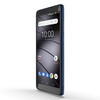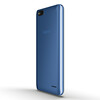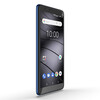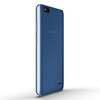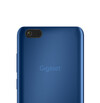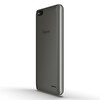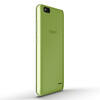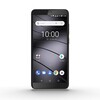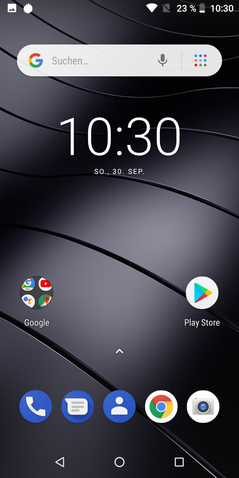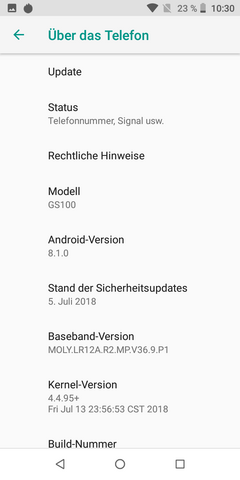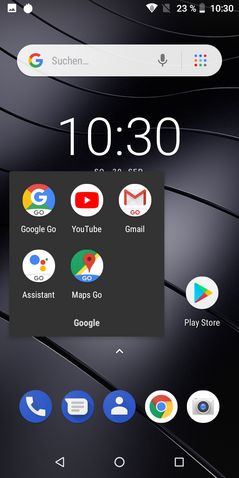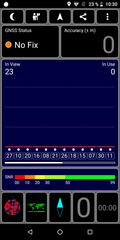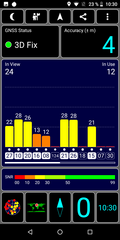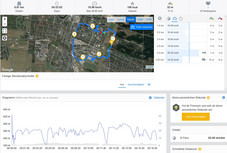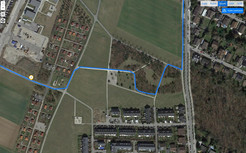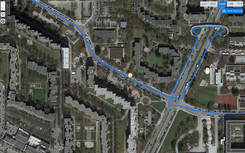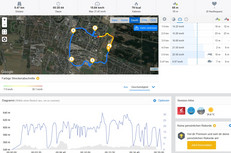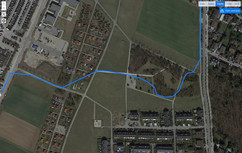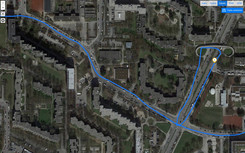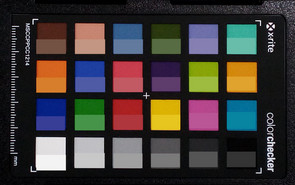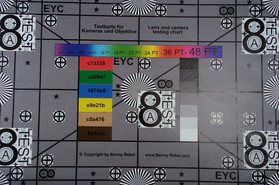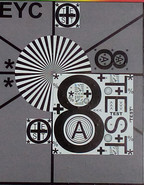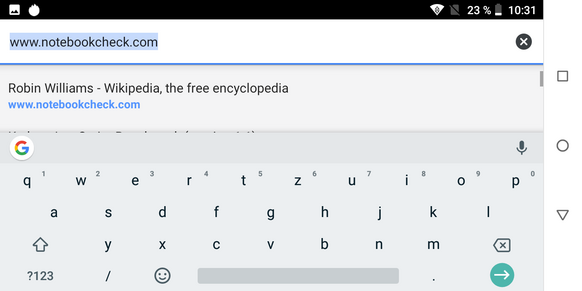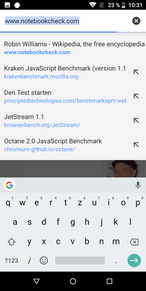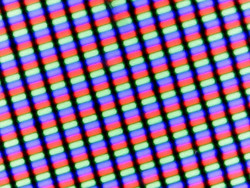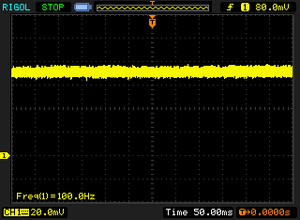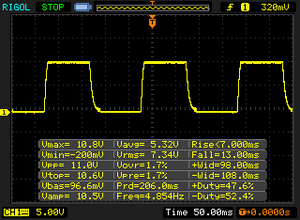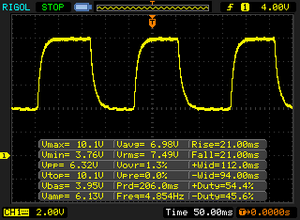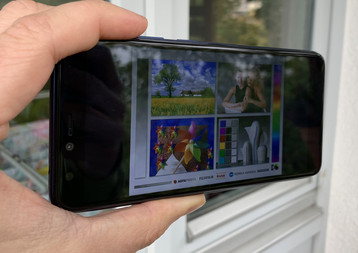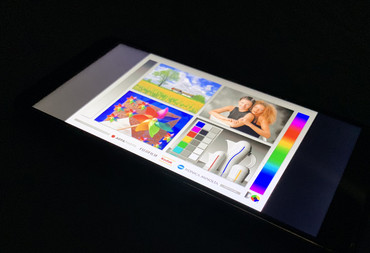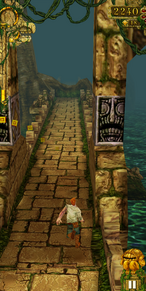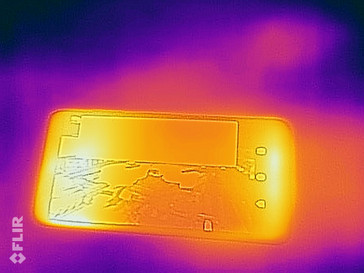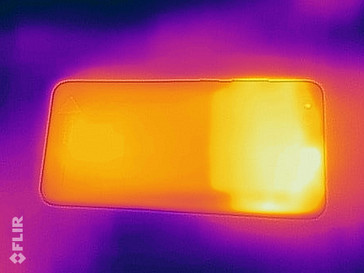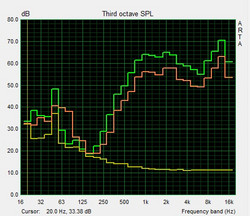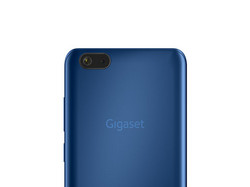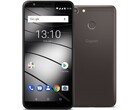Gigaset GS100 Smartphone Review
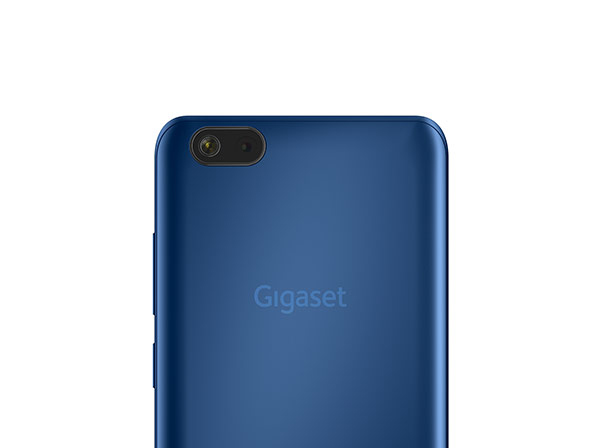
Gigaset has released a range of exciting devices this year that we have already reviewed, including mid-range devices like the GS370 Plus, the GS270 and the GS270 Plus. We have also seen more budget devices like the GS185 and the GS180, which Gigaset now complements with the release of the GS100, a 119-Euro (~$136) device that is currently the cheapest smartphone that Gigaset sells. The GS100 has a 5.5-inch display, a removable battery and LTE support among other things.
The budget smartphone market is burgeoning, so we have plenty of devices from which to choose. We have chosen to compare the GS100 against the Huawei Y7 2018, the Honor 7S, the UMIDIGI A1 Pro and the Xiaomi Redmi Note 5A Prime. Read on to find out how this German budget device fares against its competitors from Asia.
Case
The GS100 has a simple plastic case. There are advantages and disadvantages to this cheap construction though. On the one hand, you can take the back off, which reveals a removable battery. However, the case lacks rigidity and absorbs no pressure as a metal case would. The display on our test device noticeably distorted regardless of where on the case we applied pressure and the force with which we did so.
Gigaset kits the GS100 out with blue, gray or green cases; all variants have black display bezels though. The GS100 weighs 174 g despite its mainly plastic construction, making it heavier than all our comparison devices.
Connectivity
Gigaset equips the GS100 with 1 GB RAM and 8 GB of internal storage. By contrast, all our comparison devices have at least double the RAM and storage. The GS100 supports up to 128 GB microSD cards should you need more storage and the system can format cards as internal storage, apps are not savable to microSD cards.
The GS100 is a dual-SIM device that also has a dedicated FM radio receiver on board.
Software
Our test device arrived running Android Oreo 8.1 Go and the July 5, 2018 Android security patch. We would like to see the latter updated as it is never good to use a device with outdated security patches. Whether Gigaset will update the GS100’s security patches is unknown at the time of writing. Gigaset has left the OS largely unchanged, so newcomers to the Go platform will find their feet quickly.
Android Go uses scaled-down apps that take up less storage and require fewer resources than their full-fat counterparts. These “Go” apps often are just web wrappers though. While the “Go” apps inevitably save space, we could not uninstall them from our test device, effectively reducing the amount of storage space free for the user. You can install the full versions of “Go” apps, but then you will have two slightly different versions of the same app installed, with the only option being to remove the full-sized versions.
Communication & GPS
The GS100 supports IEEE 802.11 b/g/n Wi-Fi networks, which means that our test device can only connect to 2.4 GHz networks and not 5 GHz networks. Despite this, our test device reached almost 100 Mb/s in our standardized iperf3 Client Wi-Fi tests with our Linksys EA8500 reference router. Our test device achieved almost double the transfer speeds of all our comparison devices.
The GS100 supports all main LTE frequencies for using the device in Central Europe, but the device lacks LTE coverage for use in other continents. Our test device maintained at least half signal strength on the German D2 LTE network when testing the device in a built-up area.
| Networking | |
| iperf3 transmit AX12 | |
| Gigaset GS100 | |
| Honor 7S | |
| Xiaomi Redmi Note 5A Prime | |
| Umidigi A1 Pro | |
| Huawei Y5 2018 | |
| iperf3 receive AX12 | |
| Gigaset GS100 | |
| Honor 7S | |
| Umidigi A1 Pro | |
| Xiaomi Redmi Note 5A Prime | |
| Huawei Y5 2018 | |
Our test device could not locate us indoors but manages an accuracy of up to four meters outside.
We also took the GS100 on a bike ride to compare our test device’s location accuracy against a professional navigation device, the Garmin Edge 520. Our test device recorded the course comparatively well for its price but deviated by 400 m over the 5.87 km total distance that the Garmin recorded. The route that our test device plotted is crude, but overall the GS100 is accurate enough for occasional navigation tasks.
Telephone Function & Call Quality
Our test device has average call quality, making our call partner’s voice sound thin when making a call using the earpiece, albeit clear enough at high volumes. Likewise, our voice sounded thin too, and the microphone picked up plenty of background noise.
The call quality over speakerphone is akin to that of the earpiece: Voices sound thin, and the microphone picks up background noise. Oddly, our test device captures background noise even when making a call from a quiet room.
Cameras
The GS100 has a 5 MP front-facing camera and an 8 MP rear-facing sensor, both of which have a dedicated LED flash. The former particularly needs an LED flash too as generally, it takes noticeably underexposed photos. Equally underwhelming are the dynamics in bright areas, which leave much to be desired.
The main camera is better suited for landscape photography than for taking pictures of objects. Again, photos are underexposed and have poor dynamic range. Low-light performance is predictably worse; photos are blurry and have lots of image noise even in relatively good lighting.
The GS100 can record videos in up to 720p at 30 FPS, which is the absolute minimum quality that we expect from current smartphones. Moreover, the rear-facing camera visibly graduates exposure levels as the ambient lighting changes. Generally, videos have noticeable image noise.
In short, we would only recommend using the GS100 for occasional snapshots.
We also subjected our test device to camera tests under controlled lighting conditions. Again, dynamics are poor, particularly in dark areas of our test chart. Additionally, there is considerable image noise, and colors are typically darker than reference colors. By contrast, our test device sharply reproduces our test chart.
Accessories & Warranty
Gigaset includes a battery, a charger, a USB Type-A to Micro USB cable and a quick-start guide in the box. Gigaset sells a GS100 specific screen protector on its online store, but they do not sell any replacement batteries, back covers or cases.
The GS100 comes with 24 months manufacturer’s warranty. Please see our Guarantees, Return policies and Warranties FAQ for country-specific information.
Input Devices & Operation
The touchscreen is easy to use and remains accurate even into its corners. However, there is a noticeable amount of input lag, but that is because of slow system performance rather than a touchscreen-related issue.
The GS100 has two physical buttons, a power button and volume rocker, which are both on the right-hand side of the device. The power button feels spongy and imprecise, which limits the functionality of the device given how frequently the power button is used.
Display
The GS100 has a 5.5-inch IPS display with a 2:1 aspect ratio that runs at a native resolution of 1440x720. The display’s maximum brightness and resolution are on par with our comparison devices, although the UMIDIGI A1 Pro gets around 30% brighter than our test device. Our test device has an 86% uniformly lit display according to X-Rite i1Pro 2, which is between 6 and 12% behind three of our four comparison devices. In practice, large areas of homogeneous color may look less uniformly lit on the GS100 than the Honor 7S, for example.
| |||||||||||||||||||||||||
Brightness Distribution: 86 %
Center on Battery: 442 cd/m²
Contrast: 1263:1 (Black: 0.35 cd/m²)
ΔE ColorChecker Calman: 8.03 | ∀{0.5-29.43 Ø4.77}
ΔE Greyscale Calman: 10.4 | ∀{0.09-98 Ø5}
95.2% sRGB (Calman 2D)
Gamma: 2.02
CCT: 10070 K
| Gigaset GS100 IPS, 1440x720, 5.5" | Honor 7S IPS, 1440x720, 5.5" | Huawei Y5 2018 IPS, 1440x720, 5.5" | Xiaomi Redmi Note 5A Prime IPS, 1280x720, 5.5" | Umidigi A1 Pro IPS, 1440x720, 5.5" | |
|---|---|---|---|---|---|
| Screen | 10% | -25% | 13% | 32% | |
| Brightness middle (cd/m²) | 442 | 422 -5% | 475 7% | 469 6% | 594 34% |
| Brightness (cd/m²) | 446 | 417 -7% | 470 5% | 464 4% | 570 28% |
| Brightness Distribution (%) | 86 | 96 12% | 91 6% | 92 7% | 86 0% |
| Black Level * (cd/m²) | 0.35 | 0.58 -66% | 0.76 -117% | 0.6 -71% | 0.22 37% |
| Contrast (:1) | 1263 | 728 -42% | 625 -51% | 782 -38% | 2700 114% |
| Colorchecker dE 2000 * | 8.03 | 3.29 59% | 9.12 -14% | 3.31 59% | 6.63 17% |
| Colorchecker dE 2000 max. * | 15.81 | 6.91 56% | 18.86 -19% | 6.68 58% | 13.99 12% |
| Greyscale dE 2000 * | 10.4 | 3.1 70% | 12 -15% | 2.4 77% | 9.2 12% |
| Gamma | 2.02 109% | 2.219 99% | 2.342 94% | 2.155 102% | 2.24 98% |
| CCT | 10070 65% | 6873 95% | 9861 66% | 6626 98% | 8663 75% |
* ... smaller is better
Screen Flickering / PWM (Pulse-Width Modulation)
| Screen flickering / PWM detected | 100 Hz | ≤ 20 % brightness setting | |
The display backlight flickers at 100 Hz (worst case, e.g., utilizing PWM) Flickering detected at a brightness setting of 20 % and below. There should be no flickering or PWM above this brightness setting. The frequency of 100 Hz is very low, so the flickering may cause eyestrain and headaches after extended use. In comparison: 53 % of all tested devices do not use PWM to dim the display. If PWM was detected, an average of 8081 (minimum: 5 - maximum: 343500) Hz was measured. | |||
Our test device has a 0.35 cd/m² black value and a 1,263:1 contrast ratio, both of which are impressive for a device at this price. However, our spectrophotometer and CalMAN analysis software highlighted that the display has a strong blue tint to it, making colors look noticeably cool, despite the display’s strong contrast ratio.
There are more color-accurate devices at this price too. We would not recommend using the GS100 if you want to do any color-specific work, like determining the exact colors of a photo.
Display Response Times
| ↔ Response Time Black to White | ||
|---|---|---|
| 20 ms ... rise ↗ and fall ↘ combined | ↗ 7 ms rise | |
| ↘ 13 ms fall | ||
| The screen shows good response rates in our tests, but may be too slow for competitive gamers. In comparison, all tested devices range from 0.1 (minimum) to 240 (maximum) ms. » 42 % of all devices are better. This means that the measured response time is similar to the average of all tested devices (20.2 ms). | ||
| ↔ Response Time 50% Grey to 80% Grey | ||
| 42 ms ... rise ↗ and fall ↘ combined | ↗ 21 ms rise | |
| ↘ 21 ms fall | ||
| The screen shows slow response rates in our tests and will be unsatisfactory for gamers. In comparison, all tested devices range from 0.165 (minimum) to 636 (maximum) ms. » 66 % of all devices are better. This means that the measured response time is worse than the average of all tested devices (31.6 ms). | ||
Performance
The MediaTek MT6739 SoC powers the GS100 and is used in many other budget smartphones, including three of our four comparison devices. Despite using the same SoC, our test device scores considerably lower in CPU benchmarks than our MT6739-equipped comparison devices. The MT6739 is generally slower than the Qualcomm Snapdragon 435 SoC that powers the Xiaomi Redmi Note 5A Prime too. In daily use, the GS100 feels sluggish and frequently lags.
The MT6739 SoC integrates a PowerVR GE8100 GPU, the performance of which is equally far behind the Redmi Note 5A Prime and our other GE8100-powered comparison devices.
| AnTuTu v6 - Total Score (sort by value) | |
| Gigaset GS100 | |
| Huawei Y5 2018 | |
| Xiaomi Redmi Note 5A Prime | |
| Umidigi A1 Pro | |
| Average Mediatek MT6739 (25012 - 38060, n=13) | |
| PCMark for Android - Work 2.0 performance score (sort by value) | |
| Gigaset GS100 | |
| Honor 7S | |
| Huawei Y5 2018 | |
| Xiaomi Redmi Note 5A Prime | |
| Umidigi A1 Pro | |
| Average Mediatek MT6739 (2467 - 5377, n=16) | |
| GFXBench 3.0 - on screen Manhattan Onscreen OGL (sort by value) | |
| Gigaset GS100 | |
| Honor 7S | |
| Huawei Y5 2018 | |
| Xiaomi Redmi Note 5A Prime | |
| Umidigi A1 Pro | |
| Average Mediatek MT6739 (4.4 - 10, n=16) | |
| Average of class Smartphone (18 - 166, n=156, last 2 years) | |
| GFXBench 3.1 | |
| on screen Manhattan ES 3.1 Onscreen (sort by value) | |
| Gigaset GS100 | |
| Honor 7S | |
| Huawei Y5 2018 | |
| Xiaomi Redmi Note 5A Prime | |
| Umidigi A1 Pro | |
| Average Mediatek MT6739 (2.6 - 6.7, n=16) | |
| Average of class Smartphone (11 - 166, n=156, last 2 years) | |
| 1920x1080 Manhattan ES 3.1 Offscreen (sort by value) | |
| Gigaset GS100 | |
| Honor 7S | |
| Huawei Y5 2018 | |
| Xiaomi Redmi Note 5A Prime | |
| Umidigi A1 Pro | |
| Average Mediatek MT6739 (1.3 - 1.7, n=16) | |
| Average of class Smartphone (8.4 - 413, n=155, last 2 years) | |
We conducted our browser benchmarks with Chrome 68, in which our test device finished bottom of our comparison table in two out of three benchmarks.
| JetStream 1.1 - Total Score | |
| Umidigi A1 Pro (Chrome 66) | |
| Huawei Y5 2018 (Chrome 67) | |
| Xiaomi Redmi Note 5A Prime (Chrome 67) | |
| Honor 7S (Chrome 67) | |
| Average Mediatek MT6739 (13.4 - 18.5, n=14) | |
| Gigaset GS100 (Chrome 68) | |
| Octane V2 - Total Score | |
| Average of class Smartphone (2228 - 126661, n=195, last 2 years) | |
| Xiaomi Redmi Note 5A Prime (Chrome 67) | |
| Umidigi A1 Pro (Chrome 66) | |
| Huawei Y5 2018 (Chrome 67) | |
| Honor 7S (Chrome 67) | |
| Average Mediatek MT6739 (2093 - 3386, n=15) | |
| Gigaset GS100 (Chrome 68) | |
| Mozilla Kraken 1.1 - Total | |
| Honor 7S (Chrome 67) | |
| Huawei Y5 2018 (Chrome 67) | |
| Average Mediatek MT6739 (13599 - 18154, n=16) | |
| Gigaset GS100 (Chrome 68) | |
| Umidigi A1 Pro (Chrome 66) | |
| Xiaomi Redmi Note 5A Prime (Chrome 67) | |
| Average of class Smartphone (257 - 28190, n=155, last 2 years) | |
* ... smaller is better
Our test device can read our Toshiba Exceria Pro M501 reference microSD card, which not all budget smartphones can do. MicroSD card transfer speeds are on par with our comparison devices and well above the class average.
By contrast, our test device has considerably slower internal storage transfer speeds than the competition. The GS100 finished behind all our comparison devices in all AndroBench 3-5 internal storage benchmarks.
| Gigaset GS100 | Honor 7S | Huawei Y5 2018 | Xiaomi Redmi Note 5A Prime | Umidigi A1 Pro | Average 8 GB eMMC Flash | Average of class Smartphone | |
|---|---|---|---|---|---|---|---|
| AndroBench 3-5 | 94% | 78% | 158% | 66% | -14% | 4257% | |
| Sequential Read 256KB (MB/s) | 97.2 | 237.6 144% | 245.3 152% | 287.1 195% | 269.2 177% | 128.8 ? 33% | 2246 ? 2211% |
| Sequential Write 256KB (MB/s) | 24 | 67.1 180% | 47.8 99% | 120.3 401% | 44.4 85% | 22.1 ? -8% | 1882 ? 7742% |
| Random Read 4KB (MB/s) | 17.6 | 39.69 126% | 39 122% | 47.87 172% | 29.6 68% | 18.1 ? 3% | 298 ? 1593% |
| Random Write 4KB (MB/s) | 6.2 | 13.24 114% | 11.8 90% | 17.15 177% | 10.2 65% | 5.35 ? -14% | 346 ? 5481% |
| Sequential Read 256KB SDCard (MB/s) | 79.5 ? | 80.1 ? 1% | 81.7 ? 3% | 84.4 ? 6% | 81 ? 2% | 43.1 ? -46% | |
| Sequential Write 256KB SDCard (MB/s) | 61 ? | 61.9 ? 1% | 62.3 ? 2% | 60.2 ? -1% | 58.8 ? -4% | 29.1 ? -52% |
Games
Complex games like Asphalt 9: Legends are often not compatible with the GS100, and even those that are compatible do not play particularly smoothly. Simpler games like Angry Birds and Temple Run are playable, but they take a while to load, and there are occasional micro-stutters. In short, the GS100 is powerful enough to handle light gaming, but you will need a faster smartphone if you want to play more-demanding games.
The positional sensor and touchscreen worked well throughout testing.
Emissions
Temperature
The GS100 is a relatively cool device even under sustained load. Surface temperatures on our test device reached a maximum of 31.1 °C at idle but had an average of 29.15 °C. Predictably, surface temperatures rise when the device operates under sustained load, but only to a maximum of 34.6 °C and an average of 31.3 °C.
(+) The maximum temperature on the upper side is 34.5 °C / 94 F, compared to the average of 35.2 °C / 95 F, ranging from 21.9 to 247 °C for the class Smartphone.
(+) The bottom heats up to a maximum of 34.6 °C / 94 F, compared to the average of 34 °C / 93 F
(+) In idle usage, the average temperature for the upper side is 29.4 °C / 85 F, compared to the device average of 32.9 °C / 91 F.
Speakers
The GS100 has a small mono speaker on the rear of the device that reaches a maximum of 74.4 dB(A). The speaker is neither particularly loud nor high-pitched and is good enough for occasional audio playback; the experience is not a fun one though.
By contrast, audio output over the 3.5 mm jack and Bluetooth is clean. The connection is reliable in both instances too.
Gigaset GS100 audio analysis
(±) | speaker loudness is average but good (74.4 dB)
Bass 100 - 315 Hz
(-) | nearly no bass - on average 33.3% lower than median
(±) | linearity of bass is average (8.8% delta to prev. frequency)
Mids 400 - 2000 Hz
(±) | reduced mids - on average 5.9% lower than median
(±) | linearity of mids is average (8.1% delta to prev. frequency)
Highs 2 - 16 kHz
(+) | balanced highs - only 3% away from median
(+) | highs are linear (6.4% delta to prev. frequency)
Overall 100 - 16.000 Hz
(±) | linearity of overall sound is average (28.1% difference to median)
Compared to same class
» 73% of all tested devices in this class were better, 5% similar, 22% worse
» The best had a delta of 11%, average was 35%, worst was 134%
Compared to all devices tested
» 85% of all tested devices were better, 3% similar, 12% worse
» The best had a delta of 4%, average was 24%, worst was 134%
Huawei Y5 2018 audio analysis
(-) | not very loud speakers (63.6 dB)
Bass 100 - 315 Hz
(-) | nearly no bass - on average 21.8% lower than median
(+) | bass is linear (6.2% delta to prev. frequency)
Mids 400 - 2000 Hz
(±) | higher mids - on average 6% higher than median
(±) | linearity of mids is average (11.9% delta to prev. frequency)
Highs 2 - 16 kHz
(+) | balanced highs - only 3.4% away from median
(+) | highs are linear (5.9% delta to prev. frequency)
Overall 100 - 16.000 Hz
(±) | linearity of overall sound is average (27.8% difference to median)
Compared to same class
» 72% of all tested devices in this class were better, 5% similar, 23% worse
» The best had a delta of 11%, average was 35%, worst was 134%
Compared to all devices tested
» 84% of all tested devices were better, 3% similar, 13% worse
» The best had a delta of 4%, average was 24%, worst was 134%
Battery Life
Power Consumption
The GS100 is an economic device, particularly when compared to our comparison devices. Our test device needs a measurable amount of power when turned off, and it is less economical than other devices in standby. Generally, the GS100 is a power-efficient device that outshines the competition.
| Off / Standby | |
| Idle | |
| Load |
|
Key:
min: | |
| Gigaset GS100 3000 mAh | Honor 7S 3020 mAh | Huawei Y5 2018 3020 mAh | Xiaomi Redmi Note 5A Prime 3080 mAh | Umidigi A1 Pro 3150 mAh | Average Mediatek MT6739 | Average of class Smartphone | |
|---|---|---|---|---|---|---|---|
| Power Consumption | -39% | -4% | -12% | -16% | -8% | -12% | |
| Idle Minimum * (Watt) | 1.3 | 2.5 -92% | 1.3 -0% | 1.8 -38% | 1.8 -38% | 1.522 ? -17% | 0.847 ? 35% |
| Idle Average * (Watt) | 2.1 | 3 -43% | 1.7 19% | 2.4 -14% | 2.3 -10% | 2.17 ? -3% | 1.446 ? 31% |
| Idle Maximum * (Watt) | 2.9 | 3.8 -31% | 2.5 14% | 2.9 -0% | 3.2 -10% | 2.86 ? 1% | 1.63 ? 44% |
| Load Average * (Watt) | 4.4 | 5.4 -23% | 5.5 -25% | 4 9% | 4.7 -7% | 4.73 ? -8% | 6.95 ? -58% |
| Load Maximum * (Watt) | 5.3 | 5.7 -8% | 6.8 -28% | 6.3 -19% | 6 -13% | 5.99 ? -13% | 11.3 ? -113% |
* ... smaller is better
Battery Life
The GS100 has a 3,000 mAh battery, which is on par with our comparison devices. Our test device has comparatively poor battery life, despite its impressively low power consumption. Our test device lasted just 8 h 52 m in our Wi-Fi battery life test, during which we run a script that simulates the load required to render websites. The Honor 7S lasted for 14 hours in the same test, for example, although it does not have a removable battery like the GS100. In theory, you could overcome the GS100’s relatively poor battery life by purchasing an additional battery or two. However, we could not find GS100 replacement batteries at the time of writing.
The included 7.5 W charger recharges our test device fully in under two hours.
| Gigaset GS100 3000 mAh | Honor 7S 3020 mAh | Huawei Y5 2018 3020 mAh | Xiaomi Redmi Note 5A Prime 3080 mAh | Umidigi A1 Pro 3150 mAh | |
|---|---|---|---|---|---|
| Battery runtime | |||||
| WiFi v1.3 (h) | 8.9 | 14 57% | 11.4 28% | 10.8 21% | 10.1 13% |
Pros
Cons
Verdict
The Gigaset GS100 is not a device for those who are looking for the best value for money, nor is it suited for performance junkies. So, for whom is the GS100 designed? The removable battery is worth mentioning, but it is not a unique selling point for devices at this price. Frustratingly, Gigaset does not currently sell replacement batteries on its website either. The fast Wi-Fi performance is impressive, but it cannot overcome our test device’s slow system performance.
Moreover, the lack of case rigidity, the cheap feel of the power button and the blue tint to the display are all valid reasons against buying the GS100. We may have forgiven these shortcomings had Gigaset priced the device at around 30 Euros (~$34) cheaper, but the GS100 is too expensive when compared to its competitors.
The Gigaset GS100 has hardly any advantages over the competition; the device has a removable battery, but it is too expensive and too slow to warrant a recommendation.
We would only recommend the GS100 to those who for consider 120 Euros (~$137) as the limit for a smartphone. There are still better smartphones at this price though with better battery life, cameras and performance. In short, the Gigaset GS100 struggles in the face of better-equipped competition.
Gigaset GS100
- 10/01/2018 v6 (old)
Florian Wimmer


